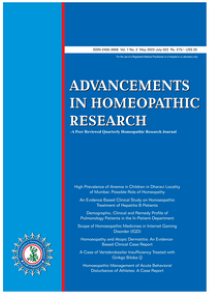Chronic Kidney Disease: A Case Series (Part 5)
DOI:
https://doi.org/10.48165/ahr.2024.9.3.5Keywords:
Haemodialysis (HD), peritoneal dialysis (PD), chronic kidney disease (CKD), chronic renal failure (CRF), end stage renal disease (ESRD), serum urea, blood urea nitrogen (BUN), serum creatinine, estimated glomerular filtration rate (eGFR), renal transplant, homoeopathic treatmentAbstract
After successful demonstration in their previous four publications that patients of chronic kidney disease (CKD) and acute renal failure (ARF) can be managed by homoeopathic treatment, Gupta et. al.
herewith put forth another episode of this case series. This fifth case series is on successful management of CKD patients by maintaining their serum creatinine level and eGFR within a reasonable range, delaying further deterioration and improving their quality of life for a considerable period of time without haemodialysis. The first two cases in this series are of 62-year and 59-year old hypertensive, diabetic males with CKD in whom S. Creatinine level was maintained for about 7 and 3 years respectively. In third case of a 47-year old hypertensive, non-diabetic male, S. Creatinine level was maintained without haemodialysis for more than 2 years.
References
1. Gupta G et.al. A clinical study on the role of homoeopathic medicines in chronic renal failure patients assessed by estimated glomerular filtration rate (eGFR), National Journal of Homoeopathy, June 2015 (189th issue); 17(6): 14-29.
2. Gupta G et.al. Chronic kidney disease: A case series, Advancements in Homoeopathic Research (formerly Asian Journal of Homoeopathy), Vol. 8, No. 2, May Jul 2023; 29-34.
3. Gupta G et.al. Chronic kidney disease: A case series (Part 2), Advancements in Homoeopathic Research, Vol. 8, No. 3, Aug-Oct 2023; 44-9.
4. Gupta G et.al. Acute renal failure: A case series (Part 3), Advancements in Homoeopathic Research, Vol. 8, No. 4, Nov-Jan 2024; 33-8.
5. Gupta G et.al. Chronic kidney disease: A case series (Part 4), Advancements in Homoeopathic Research, Vol. 9, No. 2, May-Jul 2024, pp. 31-6.
6. Skorecki K, Green J, Brenner BM. Chronic renal failure. Harrisons Principles of Internal Medicine 2005 16th edition: 1653-62.
7. Murphy R. Homoeopathic Medical Repertory, (2nd ed.), Diseases, Kidney, remedies, B. Jain publishers Pvt. Ltd. 1996; 421.
8. Boericke W. Boericke’s New Manual of Homeopathic Materia Medica with Repertory, B. Jain publishers Pvt. Ltd. (3rd revised edition) 2008; 56-58, 168-169, 217, 362-366, 448-450, 497-98.
9. Kent JT. Lectures on Homoeopathic Materia Medica, B. Jain Publishers (P) Ltd. 2009; 115-122, 424-427, 703-713, 766-772, 820-24.
10. Jha V. Current status of end-stage renal disease care in India and Pakistan. Kidney International Supplements 2013; (3): 157-160; doi: 10.1038/ kisup.2013.3. (http://www.nature.com/kisup/journal/ v3/n2/full/kisup20133a.html).
11. Singh S et.al. Homoeopathy in the management of chronic kidney disease-A narrative review. Indian J Res Homoeopathy 2022; 16(3): 216-23.
12. Ruggenenti P, Cravedi P, Remuzzi G. Mechanisms and treatment of CKD. J Am Soc Nephrol 2012; 23: 1917-28.
13. Hanna RM et. al. A practical approach to nutrition, protein-energy wasting, sarcopenia, and cachexia in patients with chronic kidney disease. Blood Purif 2020; 49: 202-11.




